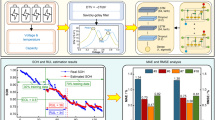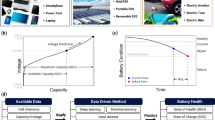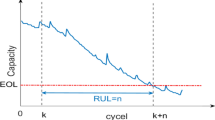Abstract
The remaining discharge energy (RDE) estimation of lithium-ion batteries heavily depends on the battery’s future working conditions. However, the traditional time series-based method for predicting future working conditions is too burdensome to be applied online. In this study, an RDE estimation method based on average working condition prediction and multi-parameter updating is proposed. First, the ohmic resistance of batteries is identified online, the temperature-aging factor is introduced against battery aging and temperature changes, and the OCV-SOC is estimated by curve scaling. Then, the future working conditions of the battery are predicted based on the average working condition prediction with less calculation. Finally, the RDE is estimated under complex working conditions. The experimental results show that the RDE estimation error of the battery is less than 3% during battery aging and temperature changes under complex working conditions. Moreover, in addition, the computational burden of the proposed method is only 1% of that of traditional methods, making it very suitable for online applications.














Similar content being viewed by others
References
Zhang H, Zhang J (2021) An overview of modification strategies to improve LiNi0·8Co0·1Mn0·1O2 (NCM811) cathode performance for automotive lithium-ion batteries. eTransportation 7
Lai X, Chen Q, Tang X, Zhou Y, Gao F, Guo Y et al (2022) Critical review of life cycle assessment of lithium-ion batteries for electric vehicles: a lifespan perspective. eTransportation 12
Chen Q, Lai X, Gu H, Tang X, Gao F, Han X et al (2022) Investigating carbon footprint and carbon reduction potential using a cradle-to-cradle LCA approach on lithium-ion batteries for electric vehicles in China. J Clean Prod 369
Burns C, Kassam A, Sinha NN, Downie L, Solnickova L, Way B et al (2013) Predicting and extending the lifetime of Li-ion cells. Conference Predicting and Extending the Lifetime of Li-Ion Cells. IOP Publishing p. 1211
Liu T, Yang X-G, Ge S, Leng Y, Wang C-Y (2021) Ultrafast charging of energy-dense lithium-ion batteries for urban air mobility. eTransportation 7
Zhang Y, Liu Y, Wang J, Zhang T (2022) State-of-health estimation for lithium-ion batteries by combining model-based incremental capacity analysis with support vector regression. Energy 239:121986
Cai T, Valecha P, Tran V, Engle B, Stefanopoulou A, Siegel J (2021) Detection of Li-ion battery failure and venting with carbon dioxide sensors. eTransportation 7
Wang X, Wei X, Zhu J, Dai H, Zheng Y, Xu X et al (2021) A review of modeling, acquisition, and application of lithium-ion battery impedance for onboard battery management. eTransportation 7
Jiang B, Zhu Y, Zhu J, Wei X, Dai H (2023) An adaptive capacity estimation approach for lithium-ion battery using 10-min relaxation voltage within high state of charge range. Energy 263:125802
Tang X, Zhou Y, Gao F, Lai X (2023) Joint estimation of state-of-charge and state-of-health for all cells in the battery pack using “leader-follower” strategy. eTransportation 15:100213
Lai X, Yuan M, Tang X, Yao Y, Weng J, Gao F et al (2022) Co-estimation of state-of-charge and state-of-health for lithium-ion batteries considering temperature and ageing. Energies 15(19):7416
Shrivastava P, Soon TK, Idris MYIB, Mekhilef S, Adnan SBRS (2022) Model‐based state of X estimation of lithium‐ion battery for electric vehicle applications. Int J Energ Res
Ren D, Feng X, Lu L, He X, Ouyang M (2019) Overcharge behaviors and failure mechanism of lithium-ion batteries under different test conditions. Appl Energy 250:323–332
Ren D, Lu L, Shen P, Feng X, Han X, Ouyang M (2019) Battery remaining discharge energy estimation based on prediction of future operating conditions. J Energy Storage 25
Liu G, Ouyang M, Lu L, Li J, Hua J (2015) A highly accurate predictive-adaptive method for lithium-ion battery remaining discharge energy prediction in electric vehicle applications. Appl Energ 149:297–314
Liu G, Ouyang M, Lu L, Li J, Han X (2015) Online estimation of lithium-ion battery remaining discharge capacity through differential voltage analysis. J Power Sources 274:971–989
Wang Y, Tian J, Sun Z, Wang L, Xu R, Li M et al (2020) A comprehensive review of battery modeling and state estimation approaches for advanced battery management systems. Renew Sustain Energy Rev 131:110015
Lai X, Huang Y, Gu H, Han X, Feng X, Dai H et al (2022) Remaining discharge energy estimation for lithium-ion batteries based on future load prediction considering temperature and ageing effects. Energy 238:121754
Barai A, Uddin K, Widanalage W, McGordon A, Jennings P (2016) The effect of average cycling current on total energy of lithium-ion batteries for electric vehicles. J Power Sources 303:81–85
Zhang W, Shi W, Ma Z (2015) Adaptive unscented Kalman filter based state of energy and power capability estimation approach for lithium-ion battery. J Power Sources 289:50–62
Rozas H, Troncoso-Kurtovic D, Ley CP, Orchard ME (2021) Lithium-ion battery state-of-latent-energy (SoLE): a fresh new look to the problem of energy autonomy prognostics in storage systems. Journal of Energy Storage 40:102735
Wang Y, Zhang C, Chen Z (2014) A method for joint estimation of state-of-charge and available energy of LiFePO 4 batteries. Appl Energ 135:81–87
Zheng L, Zhu J, Wang G, He T, Wei Y (2016) Novel methods for estimating lithium-ion battery state of energy and maximum available energy. Appl Energy 178:1–8
Chen Y, Yang X, Luo D, Wen R (2021) Remaining available energy prediction for lithium-ion batteries considering electrothermal effect and energy conversion efficiency. J Energy Storage 40
Niri MF, Bui TMN, Dinh TQ, Hosseinzadeh E, Yu TF, Marco J (2020) Remaining energy estimation for lithium-ion batteries via Gaussian mixture and Markov models for future load prediction. J Energy Storage 28
Hatherall O, Niri M F, Barai A, Li Y, Marco J (2023) Remaining discharge energy estimation for lithium-ion batteries using pattern recognition and power prediction. J Energy Storage 64
Hu X, Feng F, Liu K, Zhang L, Xie J, Liu B (2019) State estimation for advanced battery management: key challenges and future trends. Renew Sustain Energy Rev 114:109334
Laadjal K, Marques Cardoso AJ (2021) A review of supercapacitors modeling, SoH, and SoE estimation methods: issues and challenges. Int J Energ Res 45(13):18424–18440
Takyi-Aninakwa P, Wang S, Zhang H, Appiah E, Bobobee ED, Fernandez C (2022) A strong tracking adaptive fading-extended Kalman filter for the state of charge estimation of lithium-ion batteries. Int J Energ Res 46(12):16427–16444
Verma M, Basu S, Patil RS, Hariharan KS, Adiga SP, Kolake SM et al (2020) On-board state estimation in electrical vehicles: achieving accuracy and computational efficiency through an electrochemical model. Ieee T Veh Technol 69(3):2563–2575
Iurilli P, Brivio C, Wood V (2021) On the use of electrochemical impedance spectroscopy to characterize and model the aging phenomena of lithium-ion batteries: a critical review. J Power Sources 505:229860
Song Z, Yang X-G, Yang N, Delgado FP, Hofmann H, Sun J (2021) A study of cell-to-cell variation of capacity in parallel-connected lithium-ion battery cells. eTransportation 7
Hua X, Heckel C, Modrow N, Zhang C, Hales A, Holloway J et al (2021) The prismatic surface cell cooling coefficient: a novel cell design optimisation tool & thermal parameterization method for a 3D discretised electro-thermal equivalent-circuit model. eTransportation 7
Lai X, Huang Y, Han X, Gu H, Zheng Y (2021) A novel method for state of energy estimation of lithium-ion batteries using particle filter and extended Kalman filter. Journal of Energy Storage 43:103269
Lai X, Weng J, Huang Y, Yuan M, Yao Y, Han X et al (2022) A joint state-of-health and state-of-energy estimation method for lithium-ion batteries through combining the forgetting factor recursive least squares and unscented Kalman filter. Measurement 205:112187
Lai X, Wang S, Ma S, Xie J, Zheng Y (2020) Parameter sensitivity analysis and simplification of equivalent circuit model for the state of charge of lithium-ion batteries. Electrochim Acta 330:135239
Lai X, Meng Z, Wang S, Han X, Zhou L, Sun T et al (2021) Global parametric sensitivity analysis of equivalent circuit model based on Sobol’ method for lithium-ion batteries in electric vehicles. J Clean Prod 294:126246
Han X, Lu L, Zheng Y, Feng X, Li Z, Li J et al (2019) A review on the key issues of the lithium ion battery degradation among the whole life cycle. eTransportation 1
Zheng Y, Cui Y, Han X, Dai H, Ouyang M (2021) Lithium-ion battery capacity estimation based on open circuit voltage identification using the iteratively reweighted least squares at different aging levels. J Energy Storage 44
Funding
This work is supported by the National Natural Science Foundation of China (Grant Nos. 51977131 and 52277223).
Author information
Authors and Affiliations
Corresponding authors
Additional information
Publisher's Note
Springer Nature remains neutral with regard to jurisdictional claims in published maps and institutional affiliations.
Highlights
• An RDE estimation method is proposed based on average working condition prediction and multi-parameter updating.
• Battery model parameters are updated using the FFRLS algorithm.
• SOC-OCV is estimated by curve scaling.
• A simplified method for predicting the future operating conditions of batteries is proposed.
Rights and permissions
Springer Nature or its licensor (e.g. a society or other partner) holds exclusive rights to this article under a publishing agreement with the author(s) or other rightsholder(s); author self-archiving of the accepted manuscript version of this article is solely governed by the terms of such publishing agreement and applicable law.
About this article
Cite this article
Lai, X., Weng, J., Yang, Y. et al. Remaining discharge energy estimation of lithium-ion batteries based on average working condition prediction and multi-parameter updating. J Solid State Electrochem 28, 229–242 (2024). https://doi.org/10.1007/s10008-023-05683-8
Received:
Revised:
Accepted:
Published:
Issue Date:
DOI: https://doi.org/10.1007/s10008-023-05683-8




